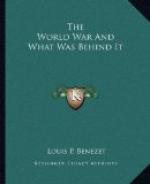[Map: Italy Made One Nation, 1914]
Questions for Review
1. Why did England and France side with Turkey against Russia? 2. What bargain did Cavour make with Napoleon III? 3. How did the rest of Italy come to join Sardinia? 4. Explain the origin of the “States of the Church.” 5. Why did Sicily and Naples revolt against their king? 6. What Italians are not yet citizens of the kingdom of Italy?
CHAPTER XII
The Man of Blood and Iron
The people demand their rights—Bismarck, the chief prop of the Prussian monarchy—The question of the leadership of the German states—The wonderful Prussian army—The war on Denmark—Preparing to crush Austria—The battle of Sadowa—Easy terms to the defeated nation—Preparing to defeat France—A good example of a war caused by diplomats—Prussia’s easy victory—The new German empire—Harsh terms of peace—The triumph of feudal government.
All of this time, the kings of Europe had been engaged in contests with their own people. The overthrow of the French king at the time of the revolution taught the people of the other countries of Europe that they too could obtain their liberties. You have already been told how the people of Austria drove out Prince Metternich, who was the leader of the party which refused any rights to the working classes.
That same year, 1848, had seen the last king driven out of France, had witnessed revolts in all parts of Italy, and had found many German princes in trouble with their subjects, who were demanding a share in the government, the right of free speech, free newspapers, and trial by jury. The empires of Austria and Russia had joined with the kingdom of Prussia in a combination which was known as the “Holy Alliance.” This was meant to stop the further spread of republican ideas and to curb the growing power of the common people.
[Illustration: Bismarck]
Not long after this, there came to the front in Prussia a remarkable man, who for the next forty years was perhaps the most prominent statesman in Europe. His full name was Otto Eduard Leopold von Bismarck-Schoenausen, but we generally know him under the name of Bismarck. He was a Prussian nobleman, a believer in the divine right of kings, the man who more than anybody else is responsible for the establishing of the present empire of Germany. He once made a speech in the Prussian Diet or council in which he said that “blood and iron,” not speeches and treaties, would unite Germany into a nation. His one object was a united Germany, which should be the strongest nation in Europe. He wanted Germany to be ruled by Prussia, Prussia to be ruled by its king, and the king of Prussia to be controlled by Bismarck. It is marvellous to see how near he came to carrying through his whole plan.




